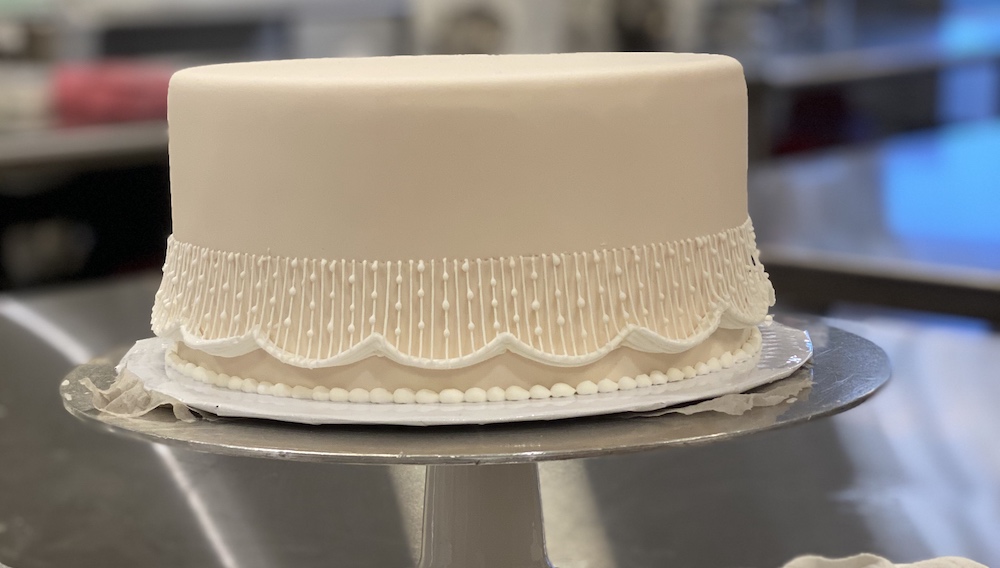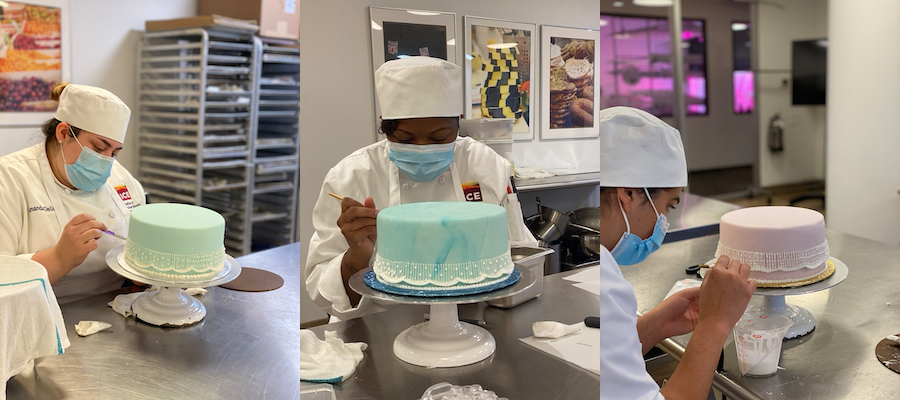On the first day of classes for the recent start of the Art of Cake Decorating program here at ICE, I asked the students what they were most excited to learn. String work didn’t come up. Until then, they hadn’t even heard of the cake decorating technique. And once they looked at some images, I think they were a bit intimidated.
The traditional technique is one perfected over a century. It involves delicate piping of royal icing, through a very small piping tip, built up upon itself to reach breathtaking gravity-defying heights. The two main forms of this highly skilled technique are Australian string work and oriental string work.
As with so many of our cake decorating traditions, string work evolved from techniques popular in England at the turn of the 20th century. According to Chef Toba Garrett, a master cake decorator and string work specialist, the story of how it’s thought to have developed is a relatable one. A cake decorator from Australia was in the UK learning from masters of overpiping — the technique of building up layers and layers of piped royal icing to create incredible sugar masterpieces. While there, sometime between 1920 and 1930, she traveled over the London Bridge. This transformative ride inspired her to consider replicating its elegant and delicate lines in sugar. I can relate. Every place I’ve ever traveled, including across my home of New York City, has been constant inspiration for my work.
As the story goes, the cake decorator went home to Australia where she practiced and developed the techniques for building the string work that seems to pop off the cake. She piped ultra-thin layers of string work over platforms or “bridges” that support them.

These cakes would have been built on the base of a fruit cake, covered in marzipan for straight edges, and then covered in rolled fondant for a perfect surface. Then the cake is marked for the curved bridge bases, which are piped repeatedly on top of each other, with time to dry in between. After the bridge is built, the cake is tilted towards the decorator, and each string is piped with a 0 tip to create ultra-delicate strings attaching to the bottom bridge, as though they are hanging in mid-air. Once these strings dry, some kind of detail piping or ornament is attached at the top string line to hide the starts.
According to Chef Toba, these cakes typically would be finished with the addition of some tiny piping work or sometimes a ribbon around the center of the cake and a tiny bow attached at the meet point, maybe a small floral spray on top. There would be no greetings or messages on the cake but maybe the name and the age. The artists wouldn’t have wanted to take away from its delicate simplicity.
Like an ice sculpture, the truth is these cakes were never really meant to be eaten. Because of the fragility, transport would have been difficult at best, and the labor involved would have made them cost-prohibitive. So mostly, Chef Toba says, they were used for cake competitions. Australian string work cakes enjoyed a height of popularity between 1950 and 1970 through the commonwealth of Great Britain, including Australia, New Zealand and South Africa.

Oriental string work is similar with its use of fine strings piped with royal icing, but in this case, the strings are dropped to create a curve. Dots are piped to attach the strings away from the cake and added layer by layer, actually turning the cake upside down during part of the process so the strings hang from the top and bottom creating elegant curves in both directions. Due to the need to turn it upside down several times, this is not really suitable for an edible cake either, but more for use in competition or display.
Both rely entirely on royal icing, a multiuse mixture of confectioner’s sugar and egg whites, plus an acid stabilizer that is firm upon piping and dries very hard. Our confectioner’s sugar in the U.S. has 3% corn starch in it. This makes the icing a bit weaker than the traditional English version. The icing sugar available in the UK does not have corn starch in it and because of that, it creates a significantly stronger icing that dries rock hard. We paddle this back and forth to remove any air bubbles that could break the strings while piping. It's then placed in a cornet, or paper cone, with a 0 tip and used only in small batches so it can be easily controlled.
As our interest in fondant-covered cakes grew in the U.S. in the 1980s and '90s, so did our interest in these traditional techniques. Those with the most skill guarded these techniques. As Chef Toba yearned to learn more, she had to work very hard to source mentors and instructors in the craft. She traveled to England to convince the masters to train her and has since become known as a master in the art. Instead of keeping it for herself, she offers instruction in this time-honored technique, passing it down to new generations — including in her design of the Art of Cake Decorating curriculum.
When it began, it could only be in white. No variation of color was allowed or accepted. Students who learn this technique now are bringing it into the 21st century, honoring the long-held techniques and traditions but adapting it for modern audiences. Specifically, the use of bold colors can assert a modern feeling with a vintage vibe. Marbleizing the fondant or the addition of other pieces of decor can make these techniques feel more at home in the present.
While the students in my cake decorating class may have started out a bit intimidated, I broke the process down into very manageable pieces, and they were able to create things they never dreamed they could. They know more about the history of how our current cake decorating techniques came to develop and where they sit among the masters that have gone before. And we’re grateful to Chef Toba for sharing her knowledge with us all. String work is one of our more traditional ways to turn humble icing and cakes into masterful works of art. With this skill in your creative toolbox, you can craft masterpieces with a wink to the past while fully embracing modern times.
Learn more about the eight-week continuing education course, The Art of Cake Decorating.




